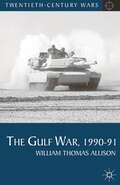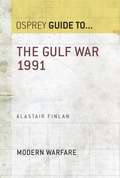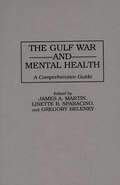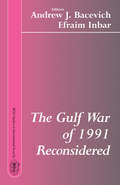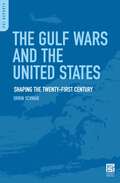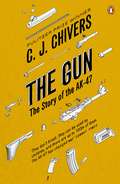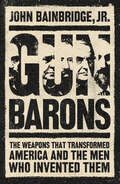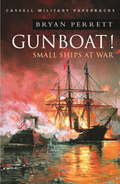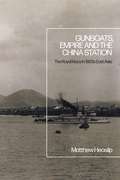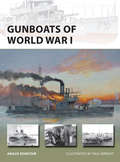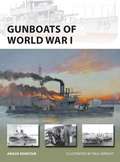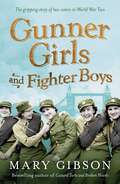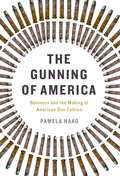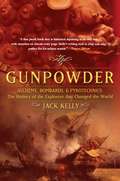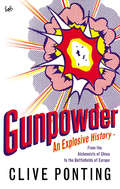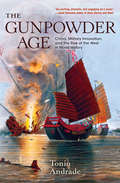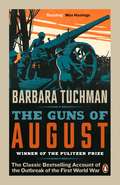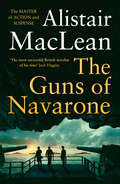- Table View
- List View
The Gulf War, 1990-91 (Twentieth Century Wars)
by William Thomas AllisonIn August 1990, Saddam Hussein's Iraqi forces boldly invaded and occupied neighboring Kuwait. It was a move that shocked the world and threatened the interests of those countries, such as the USA and the nations of Europe, dependent on oil from the Middle East. The ensuing Gulf War signaled, for many, a new dawn in warfare: one based upon lethal technology, low casualties, and quick decisive victory.Incorporating the latest scholarship, William Thomas Allison provides a concise overview of the origins, key events and legacy of the first Gulf War, as well as the major issues and debates. Allison also examines the relevance of this war to other twentieth-century conflicts and the ongoing situation in the region.
The Gulf War 1991 (Guide to...)
by Professor Alastair FinlanThe Gulf War of 1991 heralded a new type of warfare that was characterised by astonishing speed and high technology with remarkably low numbers of casualties amongst the coalition forces. Just under a million coalition personnel were deployed to the Gulf region to face a variety of threats from extreme temperatures to weapons of mass destruction (biological, chemical and suspected nuclear) and a formidable Iraqi occupation force. This book assesses the defensive Operation Desert Shield (the build up of coalition forces) and the offensive Operation Desert Storm (the liberation of Kuwait) as well as the key personalities on both sides.
The Gulf War and Mental Health: A Comprehensive Guide
by G L Belenky James Martin Linette SparacinoThe brief, successful Gulf War resulted in few casualties, but there were still recognizable pockets of trauma. This study examines the Mental Health Services available in the theater of operations, the preparations made to train the soldiers for the stress of combat, and details of how they coped with the experience of combat. It assesses the Gulf War in terms of mental health. Some attention is also given to the phenomenon named Gulf War Syndrome. The authors conclude that United States Military Forces were not prepared for the mental health requirements of combat.
The Gulf War of 1991 Reconsidered (Besa Studies In International Security)
by Andrew J. Bacevich Efraim InbarThe Gulf War of 1991 Reconsidered subjects one of the formative events of the post-Cold War era and a watershed in Middle Eastern international politics to a comprehensive reassessment. Condidering events from Arab, Israeli and American view points, the book examines the Gulf War's historical origins, conduct and legacy.
The Gulf War of 1991 Reconsidered
by Andrew J. Bacevich Efraim InbarThe Gulf War of 1991 Reconsidered subjects one of the formative events of the post-Cold War era and a watershed in Middle Eastern international politics to a comprehensive reassessment. Condidering events from Arab, Israeli and American view points, the book examines the Gulf War's historical origins, conduct and legacy.
The Gulf Wars and the United States: Shaping the Twenty-First Century (PSI Reports)
by Orrin SchwabSchwab's work is five-part analysis of US policy and strategy in the Persian Gulf from 1990-2003. He begins the work by analyzing the prominence of the Persian Gulf in US global strategic thinking during the last decade of the Cold War. By that time, gulf oil had secured a paramount place in the minds of the Reagan and Bush administrations. Part two dissects the relationship that individuals and regional governments in the Persian Gulf shared with the US. Here, Schwab also examines US perceptions of those entities and demonstrates how they helped shape the policies of the US and define the status of those nations in the eyes of US policymakers. When Saddam Hussein invaded Kuwait in 1990, the paradigm shifted dramatically. Part three examines US decision-making in the period immediately after that invasion. Schwab demonstrates that while forging a broad coalition to turn back Iraq was a significant diplomatic achievement, the international determination that defined the conflict in 1990-1991 eroded and gave way to a cumbersome policy of containment. That policy ultimately resulted in the dissolution of the coalition forged by the first Bush administration and burdened his successors as they struggled to achieve the longstanding goal of creating stability throughout the region. Part four explores the efforts of the Clinton and second Bush administrations in the Gulf. Saddam was one of the primary concerns of the Clinton administration, but so too were al-Qaeda, North Korea, China, and especially Yugoslavia. Indeed, his was the first administration to truly attempt to deal with these kinds of problems in a post-Cold War world. Despite their differences, there was a tremendous amount of continuity in the policies pursued by Clinton and George W. Bush. September 11 changed that, however, as Schwab chronicles in part five. In that section he explores how the current administration's adoption of a more proactive strategy of retaliation and preventative war has given rise to a new national security regime increasingly designed to fight asymmetric war while eliminating perceived threats to our national security and interests.Schwab's work is five-part analysis of US policy and strategy in the Persian Gulf from 1990-2003. He begins the work by analyzing the prominence of the Persian Gulf in US global strategic thinking during the last decade of the Cold War. By that time, gulf oil had secured a paramount place in the minds of the Reagan and Bush administrations. Part two dissects the relationship that individuals and regional governments in the Persian Gulf shared with the US. Here, Schwab also examines US perceptions of those entities and demonstrates how they helped shape US policy and define the status of those nations in the eyes of US policymakers. When Saddam Hussein invaded Kuwait in 1990, the paradigm shifted dramatically. Part three examines US decision-making in the period immediately after that invasion. Schwab demonstrates that while forging a broad coalition to turn back Iraq was a significant diplomatic achievement, the international determination that defined the conflict in 1990-1991 eroded and gave way to a cumbersome policy of containment. That policy ultimately resulted in the dissolution of the coalition forged by the first Bush administration and burdened his successors as they struggled to achieve the longstanding goal of creating stability throughout the region. Part four explores the efforts of the Clinton and second Bush administrations in the Gulf. Saddam was one of the primary concerns of the Clinton administration, but so too were al-Qaeda, North Korea, China, and especially Yugoslavia. Indeed, his was the first administration to truly attempt to deal with these kinds of problems in a post-Cold War world. Despite their differences, there was a tremendous amount of continuity in the policies pursued by Clinton and George W. Bush. September 11 changed that, however, as Schwab chronicles in part five. In that section he explores how the current administration's adoption of a m
The Gun: The Story of the AK-47
by C. J. ChiversThe AK-47, or 'Kalashnikov', is the most abundant and efficient firearm on earth. It is so light it can be used by children. It has transformed the way we fight wars, and its story is the chilling story of modern warfare.C. J. Chivers's extraordinary new book tells an alternative history of the world as seen through these terrible weapons. He traces them back to their origins in the early experiments of Gatling and Maxim, and examines the first appearance of the machine-gun. The quest for ever greater firepower and mobility culminated in the AK-47 at the beginning of the Cold War, a weapon so remarkable that, over sixty years after its invention and having broken free of all state control, it has become central to civil wars all over the world.
Gun Barons: The Weapons That Transformed America and the Men Who Invented Them
by John Bainbridge, Jr.“A dazzling epic of inventors, wars, arms, and men.” – Daniel Mark Epstein, author of The Lincolns: Portrait of a Marriage“Deeply researched, rich in insight, Gun Barons widens our understanding even as it enchants us with its masterful prose.” – Jim Rasenberger, author of Revolver: Sam Colt and the Six-Shooter That Changed America“John Bainbridge, Jr. cuts through the myths, romance, and propaganda to deliver true accounts of inspired drive and monomania, of catastrophic mistakes and vaults of genius.” – Doug J. Swanson, author of Cult of Glory: The Bold and Brutal History of the Texas Rangers“This book proves that guns have shaped, and continue to shape, our world.” – Howard E. Wasdin, author of Seal Team Six: The Incredible Story of an Elite Sniper“A compelling tale of action and ingenuity.” – James Grant, author of John Adams: Party of One***It’s the nineteenth century. As America prepares for civil war, five men living within ninety miles of one another will change the course of history. The invention and refinement of the repeating firearm—the precursor to today’s automatic weapons—means life in America and beyond will never be the same again.In this riveting work of narrative history, veteran reporter John Bainbridge, Jr. vividly brings to life the five charismatic and idiosyncratic men at the heart of the story: the huckster and hard-living Samuel Colt; the cunning former shirt-maker Oliver Winchester; the constant tinkerer Horace Smith; the resilient and innovative businessman Daniel Wesson; and the skinny abolitionist Christopher Spencer. As the men competed ferociously, each trying to corner the market for repeating weapons, invention and necessity collided in a perfect storm: America was crashing violently towards furious sectarianism, irrevocable tensions, and, of course, bloodthirsty war.Though capable of firing many times without reloading, astonishingly, the new guns faced a government backlash for using too much ammunition. Sold directly to soldiers, sometimes just as they were walking into battle, they quickly became coveted possessions, both during the Civil War and in the conquering of the West—and thus America’s romance with personal firearms was born.Wide-ranging and vividly told, this is a gripping story of tenacity, conviction, innovation, and pure heartless greed.
Gun Shy: The True Story of the Army Dog Scared of War
by Alison Stokes Angie McDonellVidar, the army search dog, has spent half his life sniffing out enemy weapons and bombs on the front line of the war in Afghanistan. His keen nose saved the lives of hundreds of soldiers, finding roadside bombs which could have killed British troops. But after two years of loyal service, Vidar became ‘Gun Shy’ – a term used to describe dogs who are frightened of loud noises. Whenever he heard bombs exploding or even the sound of helicopters flying above, he would curl up in the corner, shaking with fear.His army days were numbered… and his future looked uncertain. Until Angie, an army medic who befriended him during her tour of Afghanistan, made it her duty to give him a safe haven at her Welsh home.
Gunboat!: Small Ships At War (Sven Hassel War Classics)
by Bryan PerrettThis is naval action adventure with a difference - thirteen naval engagements in which gunboats won the day against every kind of enemy, large and smallBritain, like other colonial powers, established, controlled and accessed her empire from the seas. It was realised that the preservation of secure trading conditions required armed ships able to operate in shallow coastal and river waters. The gunboat was developed to meet this need: a small, shallow-draft, steam-powered screw or paddle driven vessel, sufficiently fast and manoeuvrable to take the enemy, whether on shore or afloat, by surprise.In this book Bryan Perrett recounts thirteen episodes of exciting gunboat action, ranging from the Burma war in 1824, through two world wars and on to the dramatic escape of the Amethyst down the Yangtze in 1949.
Gunboats, Empire and the China Station: The Royal Navy in 1920s East Asia
by Matthew HeaslipExamining Britain's imperial outposts in 1920s East Asia, this book explores the changes and challenges affecting the Royal Navy's third largest fleet, the China Station, as its crews fought to hold back the changing tides of fortune.Bridging the gap between high level naval strategy and everyday imperial culture, Heaslip highlights the importance of the China Station to the British imperial system, foreign policy and East Asian geopolitics, while also revealing the lived experiences of these imperial outposts. Following their immersion into a new world and the challenges they encountered along the way, it considers how its naval officers were perceived by the Chinese populations of the ports they visited, how the two communities interacted and what this meant at a time of 'peace'. Against the changing nature of Britain's informal empire in the 1920s, Gunboats, Empire and the China Station highlights the complex nature of naval operations in-between major conflicts, and calls into question how peaceful this peacetime truly was.
Gunboats, Empire and the China Station: The Royal Navy in 1920s East Asia
by Matthew HeaslipExamining Britain's imperial outposts in 1920s East Asia, this book explores the changes and challenges affecting the Royal Navy's third largest fleet, the China Station, as its crews fought to hold back the changing tides of fortune.Bridging the gap between high level naval strategy and everyday imperial culture, Heaslip highlights the importance of the China Station to the British imperial system, foreign policy and East Asian geopolitics, while also revealing the lived experiences of these imperial outposts. Following their immersion into a new world and the challenges they encountered along the way, it considers how its naval officers were perceived by the Chinese populations of the ports they visited, how the two communities interacted and what this meant at a time of 'peace'. Against the changing nature of Britain's informal empire in the 1920s, Gunboats, Empire and the China Station highlights the complex nature of naval operations in-between major conflicts, and calls into question how peaceful this peacetime truly was.
Gunboats of World War I (New Vanguard)
by Angus Konstam Mr Paul WrightNaval action in World War I conjures up images of enormous dreadnoughts slugging it out in vast oceans. Yet the truth is that more sailors were killed serving on gunboats and monitors operating far from the naval epicentre of the war than were ever killed at Jutland. Gunboat engagements during this war were bloody and hard fought, if small in scale. Austrian gunboats on the Danube fired the first shots of the war, whilst German, British and Belgian gunboats fought one of the strangest, most intriguing naval campaigns in history in far-flung Lake Tanganyika. From the Mediterranean to the Black Sea, from the Balkans to Mesopotamia, gunboats played an influential part in the story of World War I. This detailed technical guide to the gunboats of all the major navies of the war means that, for the first time, the story can be told.
Gunboats of World War I (New Vanguard)
by Paul Wright Angus KonstamNaval action in World War I conjures up images of enormous dreadnoughts slugging it out in vast oceans. Yet the truth is that more sailors were killed serving on gunboats and monitors operating far from the naval epicentre of the war than were ever killed at Jutland. Gunboat engagements during this war were bloody and hard fought, if small in scale. Austrian gunboats on the Danube fired the first shots of the war, whilst German, British and Belgian gunboats fought one of the strangest, most intriguing naval campaigns in history in far-flung Lake Tanganyika. From the Mediterranean to the Black Sea, from the Balkans to Mesopotamia, gunboats played an influential part in the story of World War I. This detailed technical guide to the gunboats of all the major navies of the war means that, for the first time, the story can be told.
Gunner Girls And Fighter Boys (The Factory Girls #3)
by Mary GibsonAn incredible story of ordinary women living extraordinary lives, from the bestselling author of Custard Tarts and Broken Hearts. London, 1939. As the Blitz hits London, two sisters from Bermondsey find their lives changed beyond all recognition. May is known to her family as the homing pigeon because of her uncanny sense of direction. She will need it when a bombing raid destroys nearly everything she holds dear. With her home in ruins, she joins the ATS and becomes a gunner girl. Here she finds dangerous work, new friends and rivals – and painful choices in love. May's elder sister, Peggy, is trapped in a stifling marriage to a small-time crook. Amid the chaos of war, a route to freedom suddenly beckons and, along with it, new and passionate love. From the melting pot of war will come hardship and tragedy, as well as new, unexpected friendships and love affairs. PRAISE FOR GUNNER GIRLS AND FIGHTER BOYS: 'I learned so much, as the history of the Second World War was brought alive through vivid writing and wonderful storytelling. From the bomb sites of London to the countryside of Surrey, to the Middle East this is one book which will take you on a journey like no other book ever written' Petra, Amazon reviewer. 'A poignant saga of an East End of London family; their lives, loves, and losses during World War 2' Barbara Bee, Amazon reviewer. 'She makes Blitz time Bermondsey come to life' Abbie Scanlon, Amazon reviewer. 'Transported me back in time with a truly wonderful story. Lots of twists and turns and I absolutely loved the way it captures all the spirit and nostalgia from those times. Love love loved it!' Jojo's, Amazon reviewer. 'Gripping to the end. Wartime heartbreak, sadness, short lived happiness and love, you can taste the debris of war and share the odd moments of emotions' Sue Thornton, Amazon reviewer.
The Gunning of America: Business and the Making of American Gun Culture
by Pamela HaagAmericans have always loved guns. This special bond was forged during the American Revolution and sanctified by the Second Amendment. It is because of this exceptional relationship that American civilians are more heavily armed than the citizens of any other nation.Or so we're told.In The Gunning of America, historian Pamela Haag overturns this conventional wisdom. American gun culture, she argues, developed not because the gun was exceptional, but precisely because it was not: guns proliferated in America because throughout most of the nation's history, they were perceived as an unexceptional commodity, no different than buttons or typewriters.Focusing on the history of the Winchester Repeating Arms Company, one of the most iconic arms manufacturers in America, Haag challenges many basic assumptions of how and when America became a gun culture. Under the leadership of Oliver Winchester and his heirs, the company used aggressive, sometimes ingenious sales and marketing techniques to create new markets for their product. Guns have never "sold themselves"; rather, through advertising and innovative distribution campaigns, the gun industry did. Through the meticulous examination of gun industry archives, Haag challenges the myth of a primal bond between Americans and their firearms. Over the course of its 150 year history, the Winchester Repeating Arms Company sold over 8 million guns. But Oliver Winchester-a shirtmaker in his previous career-had no apparent qualms about a life spent arming America. His daughter-in-law Sarah Winchester was a different story. Legend holds that Sarah was haunted by what she considered a vast blood fortune, and became convinced that the ghosts of rifle victims were haunting her. She channeled much of her inheritance, and her conflicted conscience, into a monstrous estate now known as the Winchester Mystery House, where she sought refuge from this ever-expanding army of phantoms.In this provocative and deeply-researched work of narrative history, Haag fundamentally revises the history of arms in America, and in so doing explodes the clichés that have created and sustained our lethal gun culture.
The Gunning of America: Business and the Making of American Gun Culture
by Pamela HaagAmericans have always loved guns. This special bond was forged during the American Revolution and sanctified by the Second Amendment. It is because of this exceptional relationship that American civilians are more heavily armed than the citizens of any other nation. Or so we're told. In The Gunning of America, historian Pamela Haag overturns this conventional wisdom. American gun culture, she argues, developed not because the gun was exceptional, but precisely because it was not: guns proliferated in America because throughout most of the nation's history, they were perceived as an unexceptional commodity, no different than buttons or typewriters. Focusing on the history of the Winchester Repeating Arms Company, one of the most iconic arms manufacturers in America, Haag challenges many basic assumptions of how and when America became a gun culture. Under the leadership of Oliver Winchester and his heirs, the company used aggressive, sometimes ingenious sales and marketing techniques to create new markets for their product. Guns have never "sold themselves"; rather, through advertising and innovative distribution campaigns, the gun industry did. Through the meticulous examination of gun industry archives, Haag challenges the myth of a primal bond between Americans and their firearms. Over the course of its 150 year history, the Winchester Repeating Arms Company sold over 8 million guns. But Oliver Winchester-a shirtmaker in his previous career-had no apparent qualms about a life spent arming America. His daughter-in-law Sarah Winchester was a different story. Legend holds that Sarah was haunted by what she considered a vast blood fortune, and became convinced that the ghosts of rifle victims were haunting her. She channeled much of her inheritance, and her conflicted conscience, into a monstrous estate now known as the Winchester Mystery House, where she sought refuge from this ever-expanding army of phantoms. In this provocative and deeply-researched work of narrative history, Haag fundamentally revises the history of arms in America, and in so doing explodes the clichéthat have created and sustained our lethal gun culture.
Gunpowder: Alchemy, Bombards, and Pyrotechnics: The History of the Explosive that Changed the World
by Jack KellyWhen Chinese alchemists fashioned the first manmade explosion sometime during the tenth century, no one could have foreseen its full revolutionary potential. Invented to frighten evil spirits rather than fuel guns or bombs-neither of which had been thought of yet-their simple mixture of saltpeter, sulfur, and charcoal went on to make the modern world possible. As word of its explosive properties spread from Asia to Europe, from pyrotechnics to battleships, it paved the way for Western exploration, hastened the end of feudalism and the rise of the nation state, and greased the wheels of the Industrial Revolution.With dramatic immediacy, novelist and journalist Jack Kelly conveys both the distant time in which the "devil's distillate” rose to conquer the world, and brings to rousing life the eclectic cast of characters who played a role in its epic story, including Michelangelo, Edward III, Vasco da Gama, Cortés, Guy Fawkes, Alfred Nobel, and E. I. DuPont. A must-read for history fans and military buffs alike, Gunpowder brings together a rich terrain of cultures and technological innovations with authoritative research and swashbuckling style.
Gunpowder: An Explosive History - from the Alchemists of China to the Battlefields of Europe
by Clive PontingFor many, gunpowder is associated with Guy Fawkes and the attempt to blow up parliament on 5 November 1605. Fewer people know that the formula for gunpowder was in fact discovered more than 1,000 years ago - in China - and by accident - and was initially a medicine.This fascinating book tells the story of the huge impact of gunpowder on every state and empire in the world. For 400 years the Chinese kept it to themselves, until a Mongol soldier leaked the secret to the Islamic world, where gunpowder played a crucial role in the rise of the great empires of the Ottomans and the Mughals: the spectacular capture of Constantinople in 1453 was accomplished through new siege tactics, while India was conquered with muskets and artillery mounted on 700 carts held together with ox harnesses.Even more important was the impact of gunpowder on Europe, where new weapons created new states and helped Europeans go on to dominate the rest of the world. Packed with unexpected and interesting facts, Gunpowder is an exciting, devastating and important story.
The Gunpowder Age: China, Military Innovation, and the Rise of the West in World History
by Tonio AndradeThe Chinese invented gunpowder and began exploring its military uses as early as the 900s, four centuries before the technology passed to the West. But by the early 1800s, China had fallen so far behind the West in gunpowder warfare that it was easily defeated by Britain in the Opium War of 1839–42. What happened? In The Gunpowder Age, Tonio Andrade offers a compelling new answer, opening a fresh perspective on a key question of world history: why did the countries of western Europe surge to global importance starting in the 1500s while China slipped behind?Historians have long argued that gunpowder weapons helped Europeans establish global hegemony. Yet the inhabitants of what is today China not only invented guns and bombs but also, as Andrade shows, continued to innovate in gunpowder technology through the early 1700s—much longer than previously thought. Why, then, did China become so vulnerable? Andrade argues that one significant reason is that it was out of practice fighting wars, having enjoyed nearly a century of relative peace, since 1760. Indeed, he demonstrates that China—like Europe—was a powerful military innovator, particularly during times of great warfare, such as the violent century starting after the Opium War, when the Chinese once again quickly modernized their forces. Today, China is simply returning to its old position as one of the world's great military powers.By showing that China’s military dynamism was deeper, longer lasting, and more quickly recovered than previously understood, The Gunpowder Age challenges long-standing explanations of the so-called Great Divergence between the West and Asia.
The Gunpowder Age: China, Military Innovation, and the Rise of the West in World History
by Tonio AndradeThe Chinese invented gunpowder and began exploring its military uses as early as the 900s, four centuries before the technology passed to the West. But by the early 1800s, China had fallen so far behind the West in gunpowder warfare that it was easily defeated by Britain in the Opium War of 1839–42. What happened? In The Gunpowder Age, Tonio Andrade offers a compelling new answer, opening a fresh perspective on a key question of world history: why did the countries of western Europe surge to global importance starting in the 1500s while China slipped behind?Historians have long argued that gunpowder weapons helped Europeans establish global hegemony. Yet the inhabitants of what is today China not only invented guns and bombs but also, as Andrade shows, continued to innovate in gunpowder technology through the early 1700s—much longer than previously thought. Why, then, did China become so vulnerable? Andrade argues that one significant reason is that it was out of practice fighting wars, having enjoyed nearly a century of relative peace, since 1760. Indeed, he demonstrates that China—like Europe—was a powerful military innovator, particularly during times of great warfare, such as the violent century starting after the Opium War, when the Chinese once again quickly modernized their forces. Today, China is simply returning to its old position as one of the world's great military powers.By showing that China’s military dynamism was deeper, longer lasting, and more quickly recovered than previously understood, The Gunpowder Age challenges long-standing explanations of the so-called Great Divergence between the West and Asia.
The Gunpowder Age: China, Military Innovation, and the Rise of the West in World History
by Tonio AndradeA first look at gunpowder's revolutionary impact on China's role in global historyThe Chinese invented gunpowder and began exploring its military uses as early as the 900s, four centuries before the technology passed to the West. But by the early 1800s, China had fallen so far behind the West in gunpowder warfare that it was easily defeated by Britain in the Opium War of 1839–42. What happened? In The Gunpowder Age, Tonio Andrade offers a compelling new answer, opening a fresh perspective on a key question of world history: why did the countries of western Europe surge to global importance starting in the 1500s while China slipped behind?Historians have long argued that gunpowder weapons helped Europeans establish global hegemony. Yet the inhabitants of what is today China not only invented guns and bombs but also, as Andrade shows, continued to innovate in gunpowder technology through the early 1700s—much longer than previously thought. Why, then, did China become so vulnerable? Andrade argues that one significant reason is that it was out of practice fighting wars, having enjoyed nearly a century of relative peace, since 1760. Indeed, he demonstrates that China—like Europe—was a powerful military innovator, particularly during times of great warfare, such as the violent century starting after the Opium War, when the Chinese once again quickly modernized their forces. Today, China is simply returning to its old position as one of the world's great military powers.By showing that China’s military dynamism was deeper, longer lasting, and more quickly recovered than previously understood, The Gunpowder Age challenges long-standing explanations of the so-called Great Divergence between the West and Asia.
The Gunpowder Age: China, Military Innovation, and the Rise of the West in World History
by Tonio AndradeA first look at gunpowder's revolutionary impact on China's role in global historyThe Chinese invented gunpowder and began exploring its military uses as early as the 900s, four centuries before the technology passed to the West. But by the early 1800s, China had fallen so far behind the West in gunpowder warfare that it was easily defeated by Britain in the Opium War of 1839–42. What happened? In The Gunpowder Age, Tonio Andrade offers a compelling new answer, opening a fresh perspective on a key question of world history: why did the countries of western Europe surge to global importance starting in the 1500s while China slipped behind?Historians have long argued that gunpowder weapons helped Europeans establish global hegemony. Yet the inhabitants of what is today China not only invented guns and bombs but also, as Andrade shows, continued to innovate in gunpowder technology through the early 1700s—much longer than previously thought. Why, then, did China become so vulnerable? Andrade argues that one significant reason is that it was out of practice fighting wars, having enjoyed nearly a century of relative peace, since 1760. Indeed, he demonstrates that China—like Europe—was a powerful military innovator, particularly during times of great warfare, such as the violent century starting after the Opium War, when the Chinese once again quickly modernized their forces. Today, China is simply returning to its old position as one of the world's great military powers.By showing that China’s military dynamism was deeper, longer lasting, and more quickly recovered than previously understood, The Gunpowder Age challenges long-standing explanations of the so-called Great Divergence between the West and Asia.
The Guns of August: The Classic Bestselling Account of the Outbreak of the First World War
by Barbara TuchmanBarbara Tuchman's The Guns of August is a spellbinding history of the fateful first month when Britain went to war.War pressed against every frontier. Suddenly dismayed, governments struggled and twisted to fend it off. It was no use . . .Barbara Tuchman's universally acclaimed, Pulitzer prize-winning account of how the first thirty days of battle determined the course of the First World War is to this day revered as the classic account of the conflict's opening. From the precipitous plunge into war and the brutal and bloody battles of August 1914, Tuchman shows how events were propelled by a horrific logic which swept all sides up in its unstoppable momentum.'Dazzling' Max Hastings'Magnificent' Guardian'Fascinating, splendid, glittering. One of the finest works of history' New York Times'A brilliant achievement' Sunday TelegraphBarbara Tuchman achieved prominence as a historian with The Zimmerman Telegram and international fame with the Pulitzer-Prize winning The Guns of August. She is also the author of The Proud Tower, Stilwell and the American Experience in China (also awarded the Pulitzer Prize), A Distant Mirror and The March of Folly. She died in 1989. The Proud Tower and The Zimmerman Telegram are published by Penguin.
The Guns of Navarone: Force 10 From Navarone (Cinema Classics Ser.)
by Alistair MacLeanThe classic World War II thriller from the acclaimed master of action and suspense. Now issued for the first time as an e-book.
